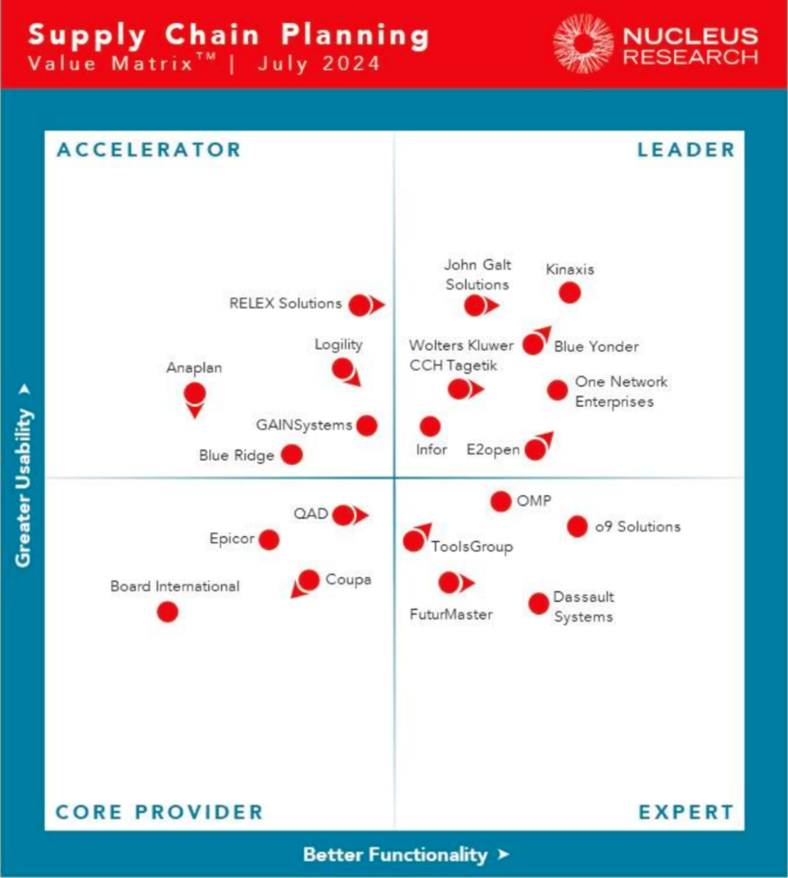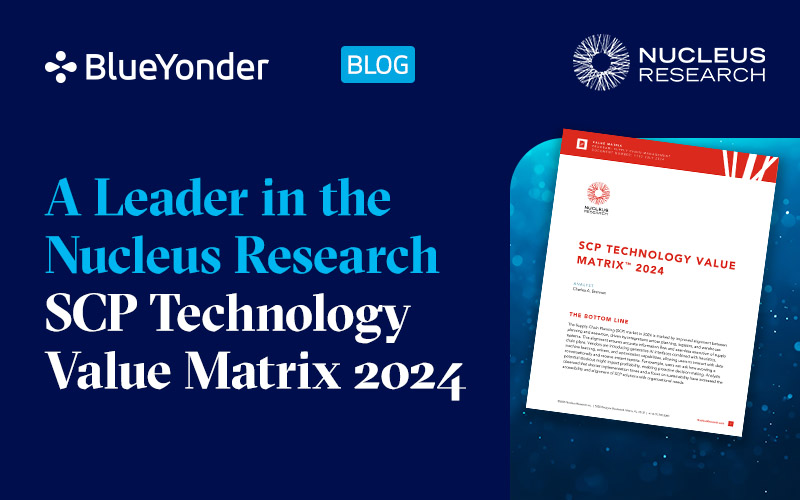Nucleus Research Names Blue Yonder a Leader in Supply Chain Planning Value Matrix™ 2024. Again.
Supply chain and IT leaders are under tremendous pressure to make the right decisions regarding supply chain planning technology investments. This investment should not only solve today’s problems but also be ready to tackle unseen future challenges, including Black Swan events like the recent IT outage. At the same time, this investment should support strategy, increase shareholder value, improve customer experience, help achieve sustainability goals, improve planner experience, enable global collaboration, reduce IT costs, provide a fast ROI … and the list goes on.
Whether you seek an upgrade or a new solution, you must evaluate many vendors across hundreds of parameters to make the right choice. Starting your assessment with vendors recognized by multiple leading analysts could ease some of the pain. In this blog, we look at the recently published SCP Technology Value Matrix™ 2024 by Nucleus Research’s Charles A Brennan, three key trends identified in the report, and what it means for your investment decisions.
The report provides an overview of the current state of the supply chain planning technology market and an analysis of major technology vendors. Blue Yonder was named a Leader in this year’s report for its industry-leading Supply Chain Planning solutions. Blue Yonder has been named a Leader for the third consecutive year, one of two vendors in the Leaders quadrant that has shown positive momentum on both the “Better Functionality” axis and the “Greater Useability” axis of the Value Matrix assessment. In addition, Blue Yonder has shown positive momentum consistently over the last five years.
In addition, Blue Yonder is also one of the few vendors named as a Leader in multiple Nucleus Research Value Matrix reports, including Warehouse Management System, Transportation Management System, and Workforce Management.

Blue Yonder’s position as a Leader is a representation of the value we deliver to our customers across manufacturing and retail, including brands like Conagra, HEINEKEN, Lenovo, L.L.Bean, Mercedes Benz USA, Michelin, Micron Technology, Morrisons, and many more. Spanning the globe, thousands of customers use Blue Yonder Supply Chain Planning solutions leveraging patented and productized artificial intelligence (AI) and machine learning (ML), and interoperable solutions that cover not only the full spectrum of planning needs but also include warehouse management, transportation management, order management, and returns management.
3 Key Trends and How They Impact Your Investment Decisions
Key Trend #1
“The supply chain planning (SCP) market in 2024 is marked by improved alignment between planning and execution, driven by integration across planning, logistics and warehouse systems.”
This is a continuation of the trend where enterprises are moving away from the point solutions that force local optimization and are investing in interoperable solutions (not just integrated) that cover supply chain planning from the boardroom to the factory floor but also include warehouse, transportation, and extended supplier network. When assessing solutions, supply chain and technology leaders should focus on how solutions can reduce friction in decision-making. This can happen when supply chain planning and execution applications work on a single platform and pull data from a single source of truth to allow users to seamlessly collaborate across supply chain functions, regions, and decision time horizons. In addition, with the volatile markets, Supply Chain Planning solutions must enable near real-time data management and simulation to empower planners to react to changes in the moment and not wait a day or week for a batch process to complete. Leaders should lean into platform-based microservices, allowing them to deploy capabilities on-demand aligned to business requirements (and not vendor restrictions) and create solutions that support their unique needs and journey.
Key Trend # 2
“Planning vendors have enhanced the user experience by combining generative AI capabilities with heuristics, machine learning, solvers, and optimization capabilities.”
Generative AI presents game-changing capabilities for supply chain decision-makers. Generative AI combined with predictive AI, machine learning, and solvers not only presents a paradigm shift in the user experience but will impact how machines support human decision-making and supply chain planning talent management. Supply chain and IT leaders must be careful when assessing generative AI solutions. Supply chains are an extremely complex ecosystem, and models that are not purpose-built for supply chains and not trained on relevant enterprise data will fail to provide the expected value and may even set back the organization. Given the critical nature of supply chains, leaders must also assess the security and scalability of generative AI implementations and seek out vendors with experience in productizing and scaling AI and ML projects to enterprise levels. Lastly, supply chain leaders must make a quantified distinction between generative AI and predictive AI capabilities and assess the value before any significant investments.
Key Trend # 3
“Sustainability is a priority in SCP, with vendors improving and rolling out ESG offerings for customers that continue to manage carbon footprints and support global decarbonization initiatives tightly.”
Conventionally, sustainability initiatives have centered on the transportation side of the supply chain, with a focus on the optimization of transportation modes, fuel types, routes, and capacity utilization. These initiatives have led to a significant reduction in emissions and savings for companies. The next step is the inclusion of ESG and sustainability in all aspects of the supply chain, especially supply chain planning – which represents a significant impact area. By developing supply chain plans that optimize ESG initiatives and profits, supply chain planners can positively impact multiple areas of supply chains, including improving the overall sustainability of the supply chain (not just in one function or at one node), responsible sourcing, waste reduction, reduced transportation costs and emissions, and reduce the pressure on downstream stakeholders. The inclusion of ESG data in strategic supply chain planning not only improves compliance with various regulations but also enables them to take advantage of various incentives that are available for more responsible organizations.
Read the full Nucleus Research SCP Technology Value Matrix™ 2024 report.
To understand how Blue Yonder Supply Chain Planning solutions can help you achieve your strategic goals, please visit our website or contact us today.

